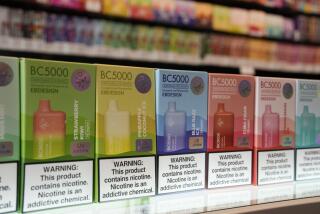Joe Camel Advent Part of Teen Smoking Rise, U.S. Says
ATLANTA — The number of American youths taking up smoking as a daily habit jumped 73% between Joe Camel’s debut in 1988 and 1996, the federal government said Thursday.
The Centers for Disease Control and Prevention said tobacco ads that rely heavily on giveaways and kid-friendly cartoons are partly to blame.
More than 1.2 million Americans younger than 18 started smoking daily in 1996, up from 708,000 in 1988, the CDC estimated.
The rate at which teens started smoking also increased, climbing 50%. In 1996, 77 of every 1,000 nonsmoking teens picked up the habit. In 1988, the rate was 51 per 1,000.
“It’s terrible news,” said Dr. Gary Giovino, chief epidemiologist for the CDC’s Office on Smoking and Health. “There’s a lot of important things to consider, which include the increase in tobacco ads that have a youth focus. The appearance of tobacco smoking in the media has just skyrocketed lately.”
A spokeswoman for R.J. Reynolds Tobacco Co. insisted that peer pressure and smoking parents are what drive most teens to smoke, not advertising. The industry has said it does not target teenagers with its advertising.
“It just doesn’t make sense to say Joe Camel fueled youth smoking,” spokeswoman Jan Smith said. “We have long said that campaign was aimed at adult smokers, period.”
The study was based on surveys of 78,330 Americans ages 12 to 66 conducted by the CDC between 1994 and 1997. Researchers extrapolated nationwide estimates from that sample.
In calculations back to 1965, the CDC estimated that the rate for beginning smokers peaked in 1977, when 67 of every 1,000 potential smokers developed a habit. The lowest rate--44 per 1,000--was in 1983.
Daily smoking rates began increasing steadily again in 1988, the same year R.J. Reynolds introduced Joe Camel in its advertising for Camel cigarettes, the CDC said.
Joe Camel was retired last year, after critics, including President Clinton, said the character was a blatant example of cigarette marketing aimed at children.
More to Read
Sign up for Essential California
The most important California stories and recommendations in your inbox every morning.
You may occasionally receive promotional content from the Los Angeles Times.










